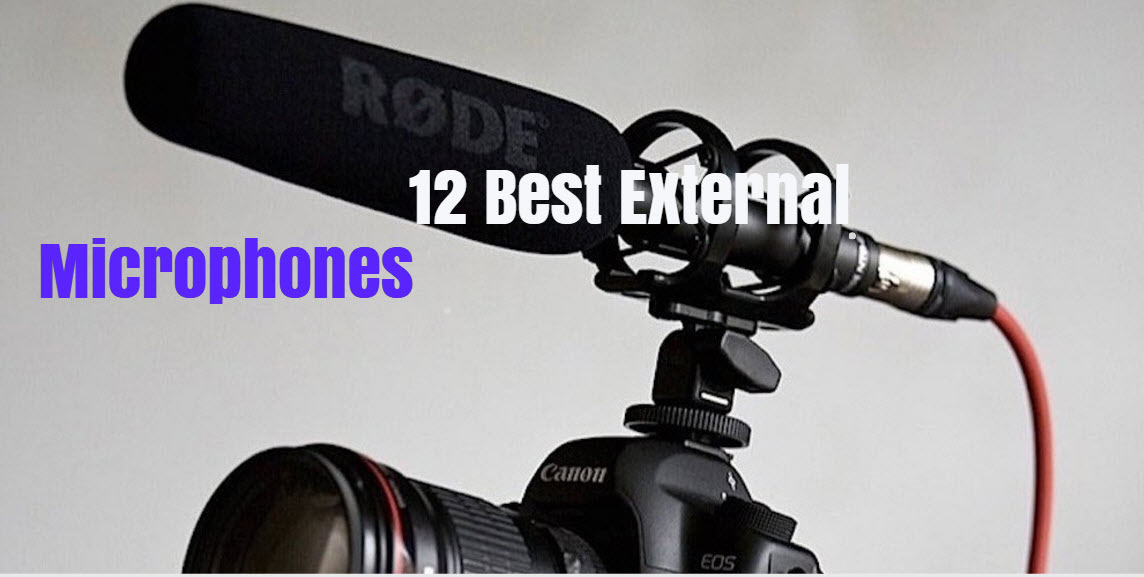Lots of people just take a camera or their smartphone and start shooting a video. That means they use built-in mics to record the sound. On the other hand, if you see professionals handling their cameras you would see separate mics mounted on the cameras. That’s because they use external mics to record sound for better quality. And professionals do succeed, professional videos basically always have better sound quality than camcorder ones. In this review, we are going to give 12 best external microphones. They fall into different categories, though.
Shotgun microphones
Shotgun microphones are the most visible on cameras and they also deliver some of the best sound qualities you can get. Once you see one shotgun mic you will understand their name. Because of the shotgun shape, they are superior at catching sound from the direction you are pointing the camera.
Audio-Technica AT875R Line
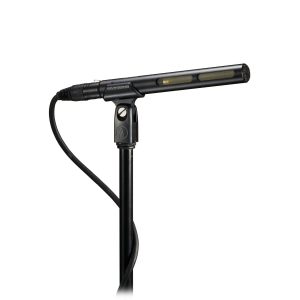
Like a good shotgun mic, AT875R has good directionality and the narrow acceptance angle necessary for long-distance sound pickup. Resulting from those 2 things the mic also offers excellent sound and noise rejection from both the sides and the rear of the mic.
The problem with built-in mics is the self-noise, they usually add hiss to your carefully filmed video. No such thing with Audio-Technica AT875R, no self-noise, and no handling noise here either.
Rode NTG2
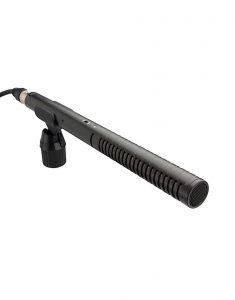
Since you lose all that noise what you get is accurate rich sound full of details. Low noise circuitry stands for “no hiss”.
To operate Rode NTG2 you need to provide 48V phantom power or just insert a 1.5V AA battery. And then it works reliably protected by rugged metal construction.
Rode SVM Stereo Condenser Microphone
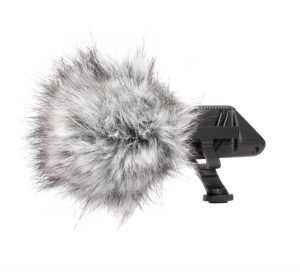
But Rode SVM Stereo still provides superior rear rejection and low noise as you get a two-step high-pass filter, flat or 80 Hz, with -10dB pad switch.
The second difference from the mics above is that plugs into the regular 3.5 mm jack and mounts with a regular shoe mount which makes operation super easy.
And like the picture shows in a somewhat exaggerated way, a custom designed windscreen comes included.
Don’t forget to power it with a 9V battery.
Lavalier Microphones
If the solution with a mic mounted on camera does not work for you, e.g. you work in a noisy room or out in the open, then the opposite solution probably works. That would be attaching them onto the person. This kind of mics is called lavalier microphones.
Audio-Technica ATR3350
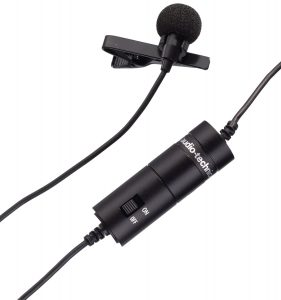
Performance figures are quite satisfactory starting with 50 – 18,000 hz frequency response. 54 dB open circuit sensitivity works for most situations and people.
ATR3350 is battery-powered as well, LR44 type. It actually has enough power to pick up voices outdoors, 10 feet away in otherwise quiet conditions.
Neewer 3.5mm Hands Free Computer Clip on Mini Lapel Microphone
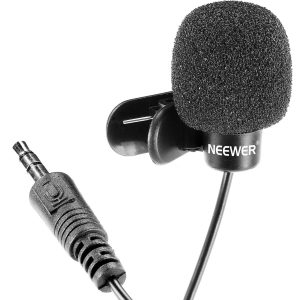
This hardware is certainly good enough for Skype, VOIP, gaming, and/or video conferencing. It does pick up some background hiss but it also picks up voice from 3 feet away. Works for extremely tall people whose mouths are way too far from shirts where this thing clips on. And you can mount it to something in front of you as well.
Rode smartLav+
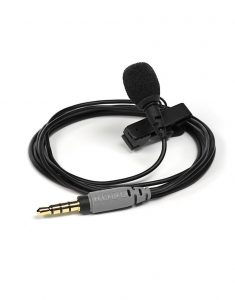
What smartLav+ actually offers is making broadcast-grade recordings with a mobile device, smartphone or a tablet. You just need to plug it. This is as portable as it gets, no complications and expenses of additional wireless equipment. Portability is enhances even more with the Kevlar reinforced cable.
The design qualifies as awesome since Rode smartLav+ features professional quality omnidirectional condenser capsule delivering equal sound pickup from all around the microphone. That makes for versatility of mounting and ensures a truly user-friendly operation.
It works with any gadget with sound recording apps installed but it works the best with RDE Rec app for Apple iOS devices.
Handheld microphones
Handheld microphones definitely qualify as external because you would not put one of those in your armpit, would you? They are also closer to the speaker than shotgun mics so they’ve been delivering quality sound for ages.
Blue Yeti USB Microphone – Blackout Edition
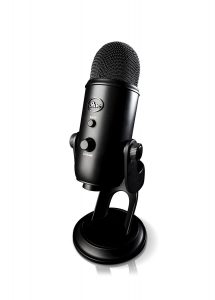
And, of course, the quality is no worse. You still get the acclaimed tri-capsule array which is essentially 3 condenser capsules catching every detail. and we remind you that Blue Yeti is the mic that lets you play switching the pattern – cardioid, bidirectional, omnidirectional or stereo. The picture also kindly shows that all the controls stayed with the Yeti. The gain control, mute button, and zero-latency headphone output are available in the same positions.
We have a full review of the Yeti available for you right here.
Audio-Technica AT2020USB Plus
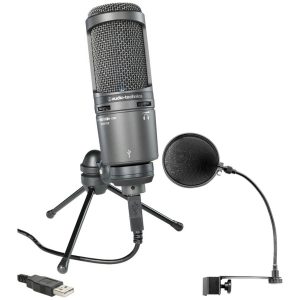
High quality A/D converter with 16 bit, 44.1/48 kHz sampling rate for superior audio will help you say words “my home studio” with less shame. Via the headphone jack with volume control, you can monitor the microphone signal with zero delay.
You can read our full review of Audio-Technica AT2020USB here.
Audio2000s ADM1064B
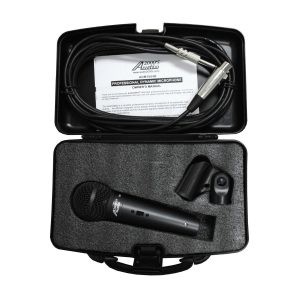
But it will not work for any kind of studio. This is a very basic dynamic mic, not a super-sensitive condenser. Don’t get me wrong, the -68 +/- 3 dB sensitivity, a result of a low impedance capsule, is quite good for a dynamic one.
As you’ve noticed the picture, this mic’s other advantage is that a long cable comes bundled and the bundle is actually a nice case.
Shure SM48S-LC
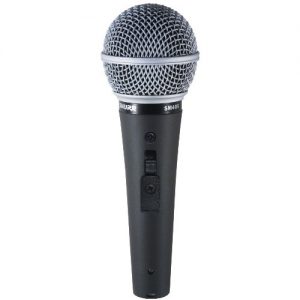
But when it comes to performance matters, SM48S offers frequency response perfect for vocals, with bright midrange and bass roll-off to control proximity effect. The true cardioid pattern is maintained throughout the entire frequency range. Another thing you going to like about this thing is high gain without feedback and it rejects off-axis sound as well.
A built-in pop filter is a nice surprise. They should have come up with that long time ago.
The package with stand adapter and carrying/storage bag is one more good thing here.
Sennheiser e935 Cardioid Dynamic
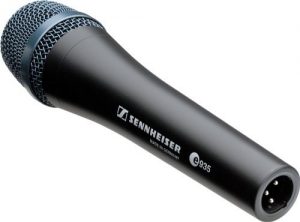
From all of that metal comes the finely calibrated, natural and defined sound.
And we have reviewed that sound for you in full right here.
Blue Microphones Spark Condenser Microphone

The versatile Blue Microphones Spark mic is designed to provide professional quality recordings. Focus Control (controlled with the visible orange button) provides two recording modes. The first mode operates with low-frequency sensitivity and that makes it good for recording a wide range of instruments. With either mode, you get great clarity and detail recorded. But the mics that are this good also record every minor speech impediment of yours, note that.
The included pop filter is not the best one, though, but it works.

